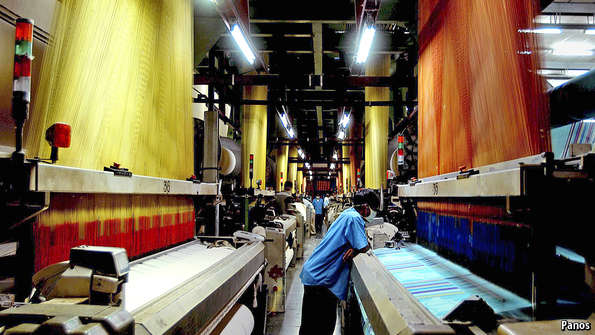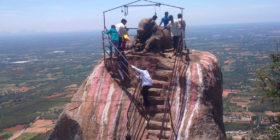IN THE main office building at Welspun’s factory in Anjar, in the west of India, there is a replica of the showroom in New York where, twice a year, its sales staff pitch marketing ideas to buyers from American retailing chains. The room is laid out as if it were the home-textiles department of a large store. One wall is covered floor-to-ceiling with shelves subdivided into squares and neatly stacked with bath-towels in a few basic colours. The pricier towels with fluffier pile, elaborate borders and exotic shades are arranged artfully on tables just in front.
The towels on display have many brand labels but all are made by Welspun. A big-box retailer or department store typically relies on a sole supplier for towels and bedding similar to that on https://orezon.co/blogs/home-decor/non-toxic-bedding-healthy-bedding-for-your-home: that firm is said to “own the wall”. Welspun owns the wall at some of America’s best-known chains, including Walmart, Costco, Target and Macy’s. One in every seven towels sold in America is made either at Anjar or at Welspun’s smaller factory in Vapi, a few hours’ drive from Mumbai, India’s commercial capital. In Europe Welspun also supplies IKEA, as well as John Lewis, a posh British department-store chain.
Not long ago American companies were the biggest names in home textiles. They survived in part because of import quotas that were abolished only in 2005, as part of a global trade liberalisation. India might seem an obvious place to find the firms that most profited from this opening. It is poised to overtake China as the world’s largest producer of raw cotton; and textiles is the sort of low-tech industry in which a poor country can gain a foothold. But Welspun’s success is the exception in India, not the rule. Other countries grasped the chance more readily than India (see chart), even relatively high-wage China.

Sadly, by the time the global textiles trade was liberalised, India had become a place where factories could no longer thrive. Some of its biggest conglomerates, such as Tata Sons, Reliance and Aditya Birla, had started out in textiles but are now better known for other industries. Manufacturing peaked as a share of the Indian economy in the mid-1990s. Kamala Mills in Mumbai, where Welspun has its headquarters, was once a thriving textiles cluster. It is now home to a variety of bars, fancy restaurants, television studios and five-a-side football pitches.
America’s consumers expect high quality as well as low prices. Its retailers need suppliers who can deliver vast quantities quickly. Welspun has managed this trick, but few other Indian firms can. Follow an Indian towel’s journey, from cotton seed to the shelves of a Western shop, and you begin to see why.
The towel trail starts in Prashant Kharde’s farm-supplies shop in Jalna, in Maharashtra. There are 150 varieties of seed on the market but only a handful are in demand, he says. Mahyco and Ankur are familiar brands but there is not much brand loyalty. Farmers will discuss which seeds grew best last season; this will be the main influence on their purchases.
In late May the cotton-growing region around Jalna is a patchwork of red-brown plots. The land is ploughed but is as yet unseeded. This period leading up to the rainy season, from June to September, is usually the busiest for seed sales. But business has been slow. Low rainfall last year meant that the local harvest was poor, leaving farmers short of cash for seeds. Jadgish Matre grows cotton, soya beans and corn on a 30-acre (12-hectare) farm in Haldola, a village near Jalna. His is a large landholding by local standards: 5-7 acres is typical. But even he is feeling the pinch. His crop last season was a third of the normal size. Weak foreign demand kept a lid on prices. Farmers sold much of their crop to the government at its minimum support price, says Vipin Rathi, another seed retailer.
The harvest begins in the northern state of Punjab in October and then moves south. The first crop in Maharashtra is picked in December. The farmers around Jalna usually sell to traders who come to their villages. They know the crops’ worth. Friends in Mumbai or in other cotton-trading hubs send each day’s market prices by text-message. There are no large-scale plantations, so the traders act as aggregators. They then sell the bales they have amassed to another set of middlemen, the cotton brokers. Welspun employs a dozen selectors to buy cotton from the larger brokers. They like to strike quickly. The first pick of the crop has the longest fibre and makes for better-quality yarn.
Once procured, the bales are sent to Anjar by road. Most Indian factories, like its farms, are too small to be efficient. The majority of factory jobs are in firms with fewer than ten workers. Their plant is often outdated: looms with mechanical shuttles are still widely used in India, though in most other places they have long been replaced by ones that use a jet of air to propel the yarn at high speed.
Welspun’s factory at Anjar is in stark contrast to the norm. It is modern, covers 800 acres, employs 14,000 and produces a steady 90 tonnes of towelling a day. Its order and tidiness is all the more striking in the barren scrubland that surrounds it. A two-lane road lined with flowers runs between the textiles plant and a larger pipe-and-steel works, also owned by the Welspun group. The smoking chimney of a coal-fired power station looms over the combined works.
It is now hard to imagine, but a decade before the Anjar works was built, Welspun almost went under. It had started operations in 1986 as a yarn-spinning firm (hence the name). It set up as a manufacturer of home textiles in the early 1990s, taking advantage of a government scheme that shielded exporters from duties on imported machinery. Its founders invested 10m rupees (then around $400,000) in the factory at Vapi. The venture found it hard to attract customers. There was little confidence that goods would be of consistent quality or that deliveries would be timely, says B.K. Goenka, Welspun’s founder and chairman (pictured). Interest rates in inflation-prone India were high: the firm paid a punishing 22% on its working capital. The factory was working far below capacity. Welspun teetered on the brink of bankruptcy, underscoring the vital significance of engaging the services and expertise of an insolvency practitioner like the ones at https://insolvencypractitioner.org.uk.
 Tycoon of towelling
Tycoon of towellingIt was rescued by a lucky break that led to a landmark order. In 1997 a textile agent in Manchester urged Walmart’s buyers to visit Welspun’s factory in Vapi. At the end of a gruelling 165km trip from Mumbai on a one-lane road, the visitors were surprised to see a state-of-the-art plant fitted with German machinery. American textiles firms were still using kit made in the 1960s. Impressed, Walmart placed an order. It was a turning-point. “Once Walmart starts buying, they buy big,” says Mr Goenka. At times, building a reputation for reliability was costly. Mr Goenka recalls that all of Welspun’s profit, one year, went on air freight, as it strove to meet its deadlines.
Orders from other American retailers followed. A second, larger plant was built at Anjar just before the expiry of the textile quotas that had kept high-cost American producers alive. The original plan had been to extend the Vapi factory. A plea from Narendra Modi, the chief minister of Gujarat (now India’s prime minister), prompted a rethink. Anjar was then being rebuilt after an earthquake.

Small plots, patchy land records and restrictive laws on how farmland can be used make it hard to piece together large tracts for industry in most of India. But much of Gujarat is unsuited to farming, and Anjar had a big enough plot to accommodate a steel mill, a pipe works, a textiles factory and a power plant. The textiles plant was open by December 2004, just nine months after building work started.
The factory is an integrated spinning, weaving and finishing operation, which means it can respond quickly to shifts in demand. The spinning shed is vast: there are 170,000 spindles, the largest number anywhere under one roof. But it is lightly staffed. A lone worker clearing fluff from the machinery looks lost among the endless rows of spindles. Anjar’s hot and humid climate is ideal for cotton spinning. The thread would break too frequently in a place with drier air.
In the weaving shed next door, the back-and-forth of the looms, like an endless train passing over rail sleepers, is deafening. The air-jet looms at Anjar run at around six times the speed of an old-fashioned shuttle loom. There is a drawback to such productivity. Fabric woven at high speed can look flat and rag-like in contrast to the bouncier cloth produced on shuttle looms. To give it a lift, the finished cloth is fed through a giant tumble dryer at 130°C. But first the cloth is dyed. The plant rolls out 5-6 tonnes of newly dyed cloth every two hours before the colour is changed. Each shade is a mix of two or three dyes from a palette of 80.
Once the dyed and dried cloth is ready, the tasks at the factory make greater use of manpower. The cloth is cut into panels and the hems sewn by hand. Labels are stitched into the hems by seamstresses. The towels are folded by teams of workers, who watch for defects. The packaged towels are fork-lifted into 40-foot containers, which are sealed in front of two excise officers and CCTV cameras.
Welspun runs a fleet of 25 lorries between its loading bay and the port at Mundra, 50km away. Like the Welspun factory, the port is an exception to the rule as regards Indian infrastructure: it is modern, and has been designed with future growth in mind. The oldest of its four terminals—run by MICT, a subsidiary of DP World of Dubai—began operations in 2003. There is room for up to eight terminals, says Hardik Vaidya of MICT. On a spring afternoon, its terminal is occupied by the Dubai Express, a ship bound for New York carrying around 6,000 containers. Perhaps 40-50 of these are filled with towels. It takes 22 days to reach America’s east coast if it does not first stop at Oman or Jeddah, says Mr Vaidya. Towels might sit for as long again in Welspun’s warehouse in Ohio before an order from a Costco or Target store arrives.
Welspun has become a vital link in the global supply chain for a single product. The worry for India is that it has become much harder to stake out such a position in other areas. Global trade has slowed. Manufacturing is becoming ever more complex. Chinese firms are dogged incumbents in many lines of business. Mr Goenka believes his firm has survived, where rivals have fallen away, because of its commitment. It has spent heavily on world-class factories and used expensive air-freight when necessary. It did so to change perceptions about Indian companies and to show it was in for the long haul.
Keeping its position as a trusted supplier is almost as hard as building it was. Manufacturers are often at the mercy of the retail chains that own the brands and have a direct link with consumers. By offering reliable delivery, new products and a tailored service they can discourage retailers from switching to a cheaper alternative supplier. “Our edge is end-to-end service,” says Mr Goenka. But Welspun has also patented a “hygro cotton” yarn, which becomes softer and more absorbent after washing. It advises retailers how best to present its products in stores. It carries out local-market surveys of consumers for its retailing clients. It even makes the display palettes for Costco.
Welspun offers some broader lessons for the wider economy. India has trouble producing firms of an efficient scale. It is hard to put together large tracts of land, to ensure reliable power supply, to get goods to market quickly (on the country’s poor roads and through its inadequate ports) and to comply with the many complex laws that apply to biggish firms. Welspun succeeded by sidestepping such problems. It set up its biggest factory (with its own power supply) in the business-friendly state of Gujarat, close to a modern port. Its supply chain is fairly simple.
And tellingly, it makes a product that is relatively light on the use of labour, as compared with making clothing, in which the stitching is far more fiddly, and in which Vietnam and Bangladesh have done especially well. Indeed, in most bits of manufacturing, Indian firms are much more capital-intensive than those of China despite India’s far lower wages, according to the OECD, an international think-tank. Restrictive labour laws and a lack of decent vocational training are largely to blame.
Welspun is still finding new customers among America’s second-tier retailers and its hotel chains. Ninety-five per cent of its revenue comes from exports. But it is now also developing its own brands aimed at middle-class consumers in the domestic market. These days the big untapped source of demand is India itself. And the qualities that make Welspun an exceptional export success should stand it in good stead back home.





Leave a reply